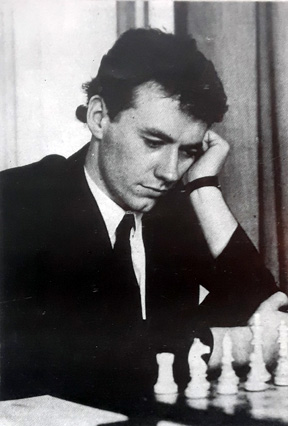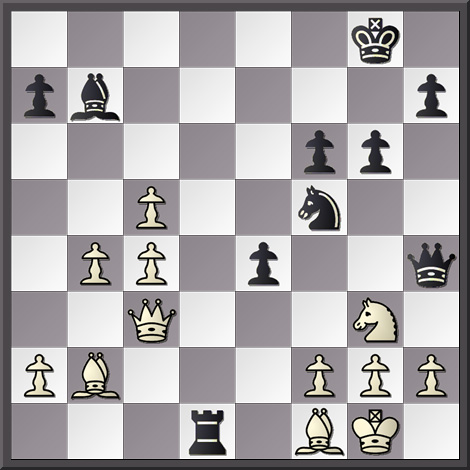 |
|
|
Mark Lockewood Condie
Born 12 February 1965, Edinburgh

Mark Condie showed outstanding talent as a youngster, holding junior records at the time for best Scot at ages 13, 14, 15, 19 and 20. He made steady progress, as shown by some of his results:
- At the 1979/80 Hastings Challengers he shared 5th-8th places with 7 points, only one point behind the winner, Brito.
- At the 1981 British Championship he scored 6/11.
- He took 10th place at the European Junior Championship 1981/2 with 7/13.
- At the European Junior Championship 1982/3 in Groningen, Netherlands, he secured 3rd place with 9½/13.
- He shared 2nd-5th places at the Lewisham International 1983 with 6 points, a half-point behind the winner, Plaskett.
- 1983 - awarded the FIDE Master title.
- Nancy Elder Memorial: College of Technology, Dundee, 24-26 February 1984: 1st with 4½/5 ahead of Motwani and G. Morrison.
- Oakham Young Masters 1984: 4½/9.
- Nat West Young Masters: 29 Sept-7 Oct 1984, London: 1st= with 5½/9 (with Hebden, Norwood and Williams, gaining his third and final IM norm.
- 1984 - awarded the International Master title.
- 1985 Scottish Champion (shared with R.M. McKay).
- At Poznan 1986 he scored 6½/11 to share 2-4th places with Blatny and Conquest, a half-point behind Neverov, whom he defeated.
- 1987 Save and Prosper Edinburgh Congress: 1st with 4½/5.
Condie represented Scotland at two Olympiads, Lucerne 1982 and Dubai 1986. In Dubai he played on the top board, but a disappointing result of 4/10 "sapped his ambition of pursuing the grandmaster title and he wound down his chess activity."
Further success beckoned, though, when Condie won the 1989 Scottish Championship with 7/9.
But, in the main, coaching juniors was preferred to tournament play. And any later thoughts of achieving the grandmaster title were dashed for health reasons; from 1997 Condie had to deal with the debilitating effects of Wilson's disease.
Here is Condie's powerful win against a future world champion. It was played in the last round of the 1986 Lloyd's Bank Masters, in which Agdestein was 1st with 8/9, followed by Hodgson 7½, 3-5 Chandler, Hjartarson and Condie 7, 6-12 Nijboer, Plaskett, Barua Kudrin, Watson, Bleiman and Rechlis 6½.
Condie - Anand
Lloyd's Bank Masters 1986 (Round 9)1. Nf3 Nf6 2. c4 e6 3. d4 c5 4. e3 g6 5. Nc3 Bg7 6. Be2 O-O 7. O-O b6 8. b3 Bb7 9. Bb2 Qe7 10. Qc2 Nc6 11. Rfd1 Rac8 12. dxc5 bxc5 13. Rd2?! Rampant Chess: It's natural to want to double rooks on the half-open file, but the position of the rook on d2 can become quite awkward (as we will see later). 13...Rfd8 14. Rad1 d5 15. Qb1 Rampant Chess: A generally useful move (it prevents the cheeky Nb4 hop coming with tempo) that tempts Black to continue his advance...which he does. 15...d4?! Rampant Chess: Black could have prepared this advance with Bh6, highlighting the Rd2 problem. Bryson pointed out that though this wins rook for bishop, it results in black square defensive problems. He offered 15...Na5 16.cxd5 exd5 as an alternative. 16. exd4 Bh6 17. dxc5 Bxd2 18. Nxd2! Nd4 Capturing the c5 pawn leads to problems: 18... Qxc5 19. Nce4 Nxe4 20. Nxe4 Rxd1+ 21. Qxd1, with Nf6+ to follow. 19. b4 e5 20. Bf1 Nf5 21. Nde4 Nxe4 22. Rxd8+ Rxd8 23. Nxe4 Qh4 24. Ng3 e4 25. Qc1 Bryson: With Qc3 in mind to target the black square weaknesses. 25...f6 Rampant Chess provided some interesting alternatives here: after 25... e3 26. Qc3 is still possible, as after 26... exf2+ 27. Kxf2 (not 27. Kh1?? Nxg3+ 28. Qxg3 Qxg3 29. hxg3 Rd1, winning) 27... Qf4+ 28. Kg1 Qe3+ Black has managed to exchange queens, but the endgame still favours White due to his dangerous queenside pawns. Rather than 26.Qc3, another possibility is
26. fxe3 Nxg3 27. hxg3 Qxg3, when 28. Bd4 cuts out all Black's counterplay, but not 28. Qc3 f6 29. Qxf6 Qxe3+ 30. Kh1 Qh6+ 31. Kg1 Qe3+ when Black escapes with perpetual check. 26. Qc3 Rd1
27. Qc2! Rampant Chess: White carefully avoids a very nasty trap. The immediate pawn advance 27. b5 e3 28. fxe3 Nxg3 29. hxg3 looks fine because 29...Qxg3 can be met by 30. c6, cutting off the bishop. But there is a sting in the tail: instead of 29...Qxg3, Black can play 29...Qe4! 30. c6 Qf5 and now it is White who must resign! Another tempting possibility is to grab a pawn with 27. Qxf6, but then after 27...Qxf6 28. Bxf6 e3 29. fxe3 Nxe3 30. Bg5 Nxc4 Black manages to eliminate at least one of those pesky queenside pawns. 27... Rd7 28. Qa4 Re7 29. Nxf5 gxf5 30. Qxa7 Kf7 31. Qb8 e3 32. fxe3 Bxg2! 33. Qg3 Rampant Chess pointed out that capturing the bishop would only lead to a draw: 33. Bxg2 Qe1+ 34. Bf1 Qxe3+ 35. Kg2 Qe4+ 36. Kf2 Qe3+. 33... Qxg3 34. hxg3 Bxf1 35. Kxf1 Rxe3 White's pawn mass decides things. 36. b5 Ke8 Or 36... Re4 37. b6 Rxc4 38. Ba3 etc.
37. c6 Kd8 38. Bxf6+ Kc8 39. c5 h6 40. a4 Re6 and Black resigned as the time control was reached. 1-0Sources
ScotlandsPeople web site.
Scottish Chess, June 1984; December 1984; September 1989.
Scotland on Sunday chess column, 14 May 1995 (Douglas Bryson).
Undated Glasgow Herald column (Craig Pritchett).
http://www.chessedinburgh.co.uk/chandlerarticle.php?ChandID=94
Mark Condie scrapbook
Compiled by Alan McGowan
Historian, Chess Scotland

